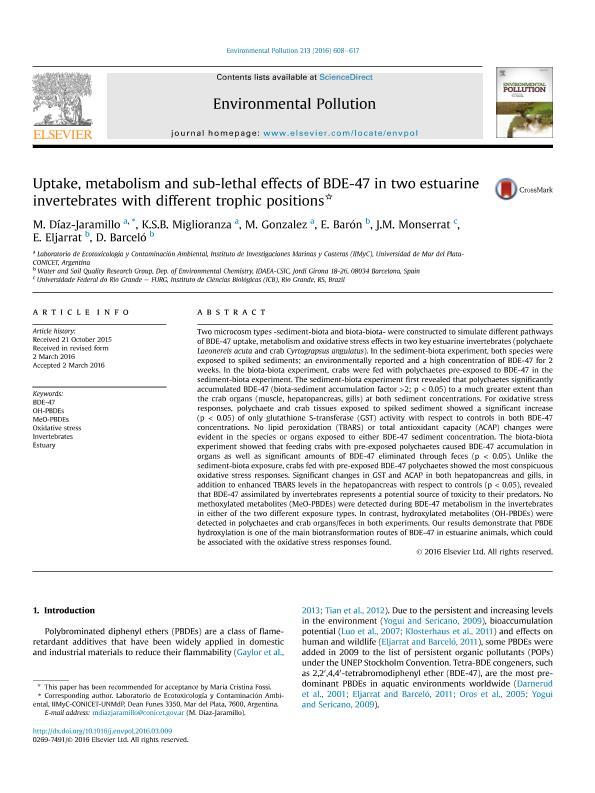Artículo
Uptake, metabolism and sub-lethal effects of BDE-47 in two estuarine invertebrates with different trophic positions
Diaz Jaramillo, Mauricio Javier ; Miglioranza, Karina Silvia Beatriz
; Miglioranza, Karina Silvia Beatriz ; Gonzalez, Mariana
; Gonzalez, Mariana ; Barón, E.; Monserrat, José María; Eljarrat, E.; Barceló, D.
; Barón, E.; Monserrat, José María; Eljarrat, E.; Barceló, D.
 ; Miglioranza, Karina Silvia Beatriz
; Miglioranza, Karina Silvia Beatriz ; Gonzalez, Mariana
; Gonzalez, Mariana ; Barón, E.; Monserrat, José María; Eljarrat, E.; Barceló, D.
; Barón, E.; Monserrat, José María; Eljarrat, E.; Barceló, D.
Fecha de publicación:
06/2016
Editorial:
Elsevier
Revista:
Environmental Pollution
ISSN:
0269-7491
Idioma:
Inglés
Tipo de recurso:
Artículo publicado
Clasificación temática:
Resumen
Two microcosm types -sediment-biota and biota-biota- were constructed to simulate different pathways of BDE-47 uptake, metabolism and oxidative stress effects in two key estuarine invertebrates (polychaete Laeonereis acuta and crab Cyrtograpsus angulatus). In the sediment-biota experiment, both species were exposed to spiked sediments; an environmentally reported and a high concentration of BDE-47 for 2 weeks. In the biota-biota experiment, crabs were fed with polychaetes pre-exposed to BDE-47 in the sediment-biota experiment. The sediment-biota experiment first revealed that polychaetes significantly accumulated BDE-47 (biota-sediment accumulation factor >2; p < 0.05) to a much greater extent than the crab organs (muscle, hepatopancreas, gills) at both sediment concentrations. For oxidative stress responses, polychaete and crab tissues exposed to spiked sediment showed a significant increase (p < 0.05) of only glutathione S-transferase (GST) activity with respect to controls in both BDE-47 concentrations. No lipid peroxidation (TBARS) or total antioxidant capacity (ACAP) changes were evident in the species or organs exposed to either BDE-47 sediment concentration. The biota-biota experiment showed that feeding crabs with pre-exposed polychaetes caused BDE-47 accumulation in organs as well as significant amounts of BDE-47 eliminated through feces (p < 0.05). Unlike the sediment-biota exposure, crabs fed with pre-exposed BDE-47 polychaetes showed the most conspicuous oxidative stress responses. Significant changes in GST and ACAP in both hepatopancreas and gills, in addition to enhanced TBARS levels in the hepatopancreas with respect to controls (p < 0.05), revealed that BDE-47 assimilated by invertebrates represents a potential source of toxicity to their predators. No methoxylated metabolites (MeO-PBDEs) were detected during BDE-47 metabolism in the invertebrates in either of the two different exposure types. In contrast, hydroxylated metabolites (OH-PBDEs) were detected in polychaetes and crab organs/feces in both experiments. Our results demonstrate that PBDE hydroxylation is one of the main biotransformation routes of BDE-47 in estuarine animals, which could be associated with the oxidative stress responses found.
Palabras clave:
Bde-47
,
Estuary
,
Invertebrates
,
Meo-Pbdes
,
Oh-Pbdes
,
Oxidative Stress
Archivos asociados
Licencia
Identificadores
Colecciones
Articulos(IIMYC)
Articulos de INSTITUTO DE INVESTIGACIONES MARINAS Y COSTERAS
Articulos de INSTITUTO DE INVESTIGACIONES MARINAS Y COSTERAS
Citación
Diaz Jaramillo, Mauricio Javier; Miglioranza, Karina Silvia Beatriz; Gonzalez, Mariana; Barón, E.; Monserrat, José María; et al.; Uptake, metabolism and sub-lethal effects of BDE-47 in two estuarine invertebrates with different trophic positions; Elsevier; Environmental Pollution; 213; 6-2016; 608-617
Compartir
Altmétricas



